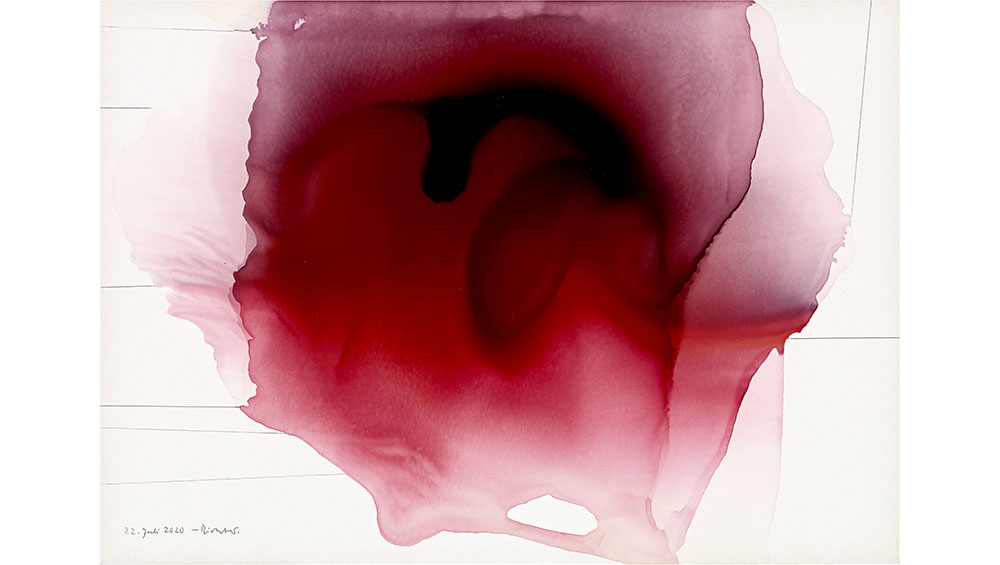
Gerhard Richter. 22. Juli 2020, 2020. Pencil, ink and coloured ink on paper, 42 x 59.3 cm. Copyright © Gerhard Richter 2021 (19032021) Courtesy the artist.
HENI Project Space, Hayward Gallery, London
9 September – 12 December 2021
by CHRISTIANA SPENS
Although better known for his vast, layered paintings – often incorporating photography and exploring its ambiguous boundary with painting – Gerhard Richter is also a draughtsman. While drawing is clearly part of his painting practice, Richter, now 89, also considers it a medium in its own right and, in the past couple of decades especially, has developed this area of his work in fascinating ways. Revealing this lesser-known aspect of Richter’s practice, the Hayward Gallery’s new exhibition of 68 drawings, many of which were produced during lockdown in Germany, presents a varied and compelling selection of work. It is the largest exhibition of Richter’s drawings to be presented in the UK to date, and the first significant show in London since Gerhard Richter: Panorama, at Tate Modern, a decade ago.
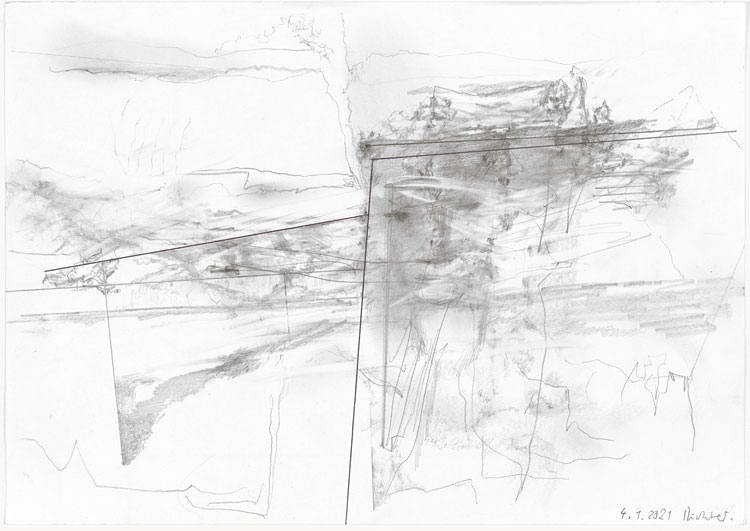
Gerhard Richter. 4.1.2021, 2021. Pencil and graphite on paper, 21 x 29.7 cm. Copyright © Gerhard Richter 2021 (19032021) Courtesy the artist.
Shown in groups intended to reveal starkly different approaches to drawing, whether through the choice of materials – using ink, graphite, incorporating photographs, or innovative compositional techniques – each section of the exhibition reveals a methodical, experimental approach to mark-making that echoes the processes and styles in Richter’s painting practice, and yet remains distinct. One set of drawings, using graphite on small pieces of paper, features abstract images, with repeating lines and shaded areas, quite architectural in their composition, and built up in layers to create a dynamic whole.
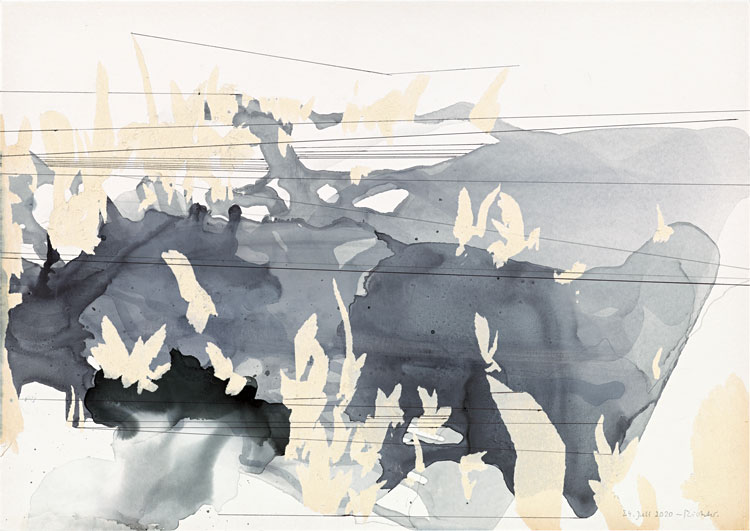
Gerhard Richter. 24. Juli 2020, 2020. Pencil, ink and coloured ink on paper, 42 x 59.3 cm. Copyright © Gerhard Richter 2021 (19032021) Courtesy the artist.
Another series of drawings, in which Richter uses coloured pencils and dyes, produces a more organic, unstructured effect, with the pigment seeming to bleed out of the graphite constraints. These works are mesmerising, and easy to lose oneself in; they seem to evoke not only the large abstract paintings of Mark Rothko, but also Rorschach tests, in their blood-red stains and anarchic puddles of ink.
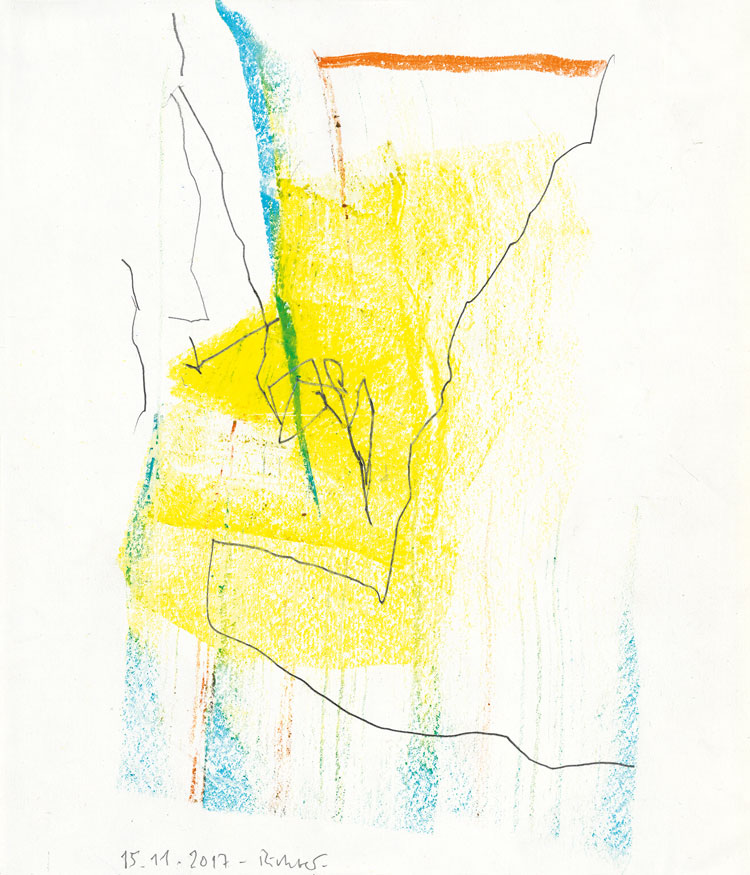
Gerhard Richter. 15.11.2017, 2017. Pencil and coloured pencil on paper, 21 x 18 cm. Copyright © Gerhard Richter 2021 (19032021) Courtesy the artist.
While these works blur the line between drawing and painting, another set – over-painted photographs – employ the techniques of scraping, smearing and erasing, that Richter is so well-known for in his painting practice. Here, using photographs of a dense forest, and then covering the trees with grey tones, representation itself is abstracted through this tactile method, producing a visceral intensity that is poignant and even disturbing. Memories scratched out, there is a sense of WG Sebald’s blurry, unclear reproductions of photographs in his literary works about history and place, implying the strange relationship we have with our own and others’ memories. Whether or not these are “drawings”, they are certainly a form of mark-making that is direct, moving and challenging to the viewer. We are trying to see what has been covered or erased; looking here is difficult and even frustrating, just as remembering may be, too.
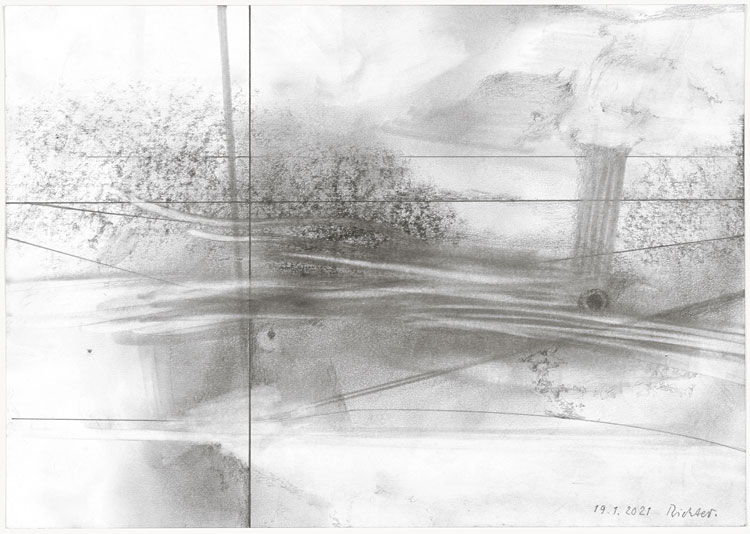
Gerhard Richter. 19.1.2021, 2021. Pencil and graphite on paper, 21 x 29.7 cm. Copyright © Gerhard Richter 2021 (19032021) Courtesy the artist.
What stands out in these works is a sense of wounding – of bleeding, scarring, healing over, reopening and recovering. Richter’s drawings speak to the healing process and its temporality, as well as to processes of illness and injury. To be wounded is nevertheless to keep living. It is in defiance of death – our bodies’ and minds’ defiance of an end. Richter suggests that we embrace this fact of life, rather than dismiss or resist it; suffering is part of living, after all. With this stoical, understated perspective and practice, this layering of experience, transformed into tactile marks, bleeds and erasures, Richter captures the visceral nature of living and perceiving the world around us.
There is also, in the exhibition overall, a sense of balance in the juxtaposition of highly structured, tightly drawn compositions, with the bleeding, overflowing ink drawings, and a harmony therein. What emerges is a sense of trying to contain oneself, and one’s memories, and experience of temporality, as one continues to feel and remember unpredictably. Richter captures everyday living and thinking and recovering in these subtle, moving works – at first glance simple and small, but taken all together a poignant exploration of living, breathing and moving on.